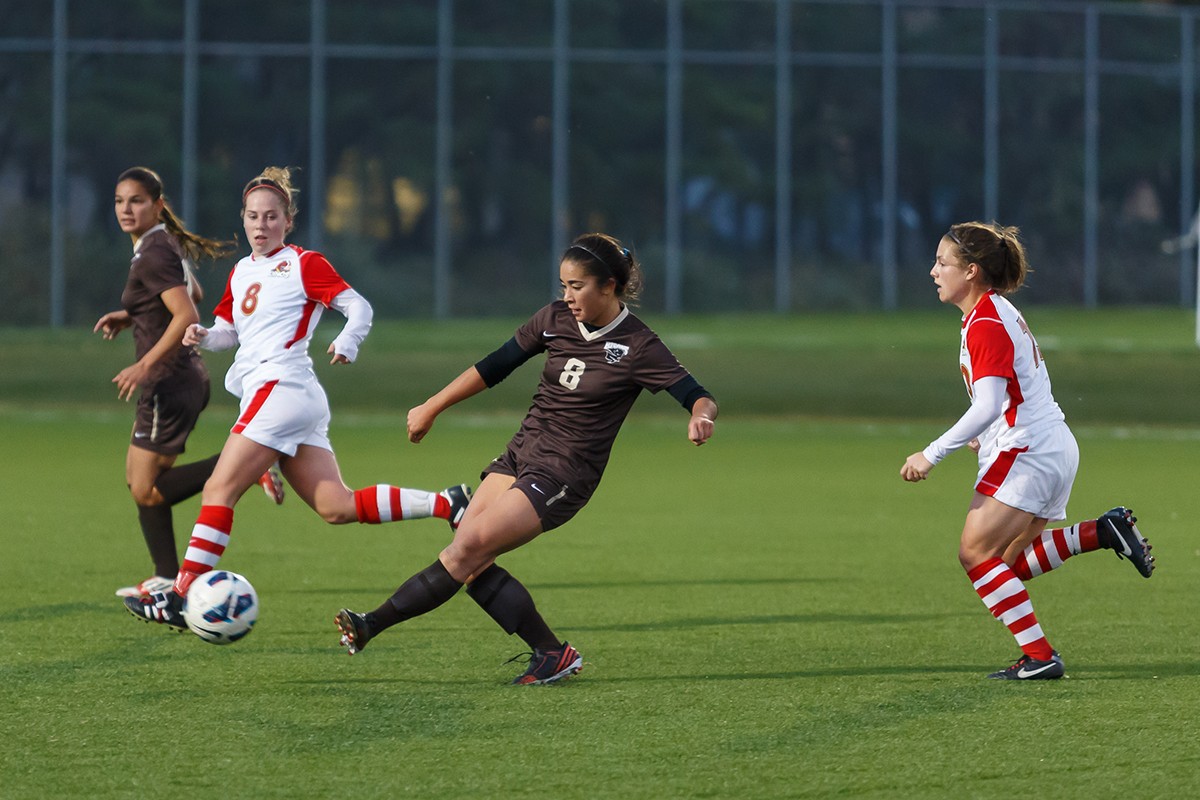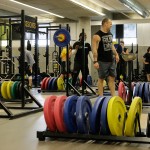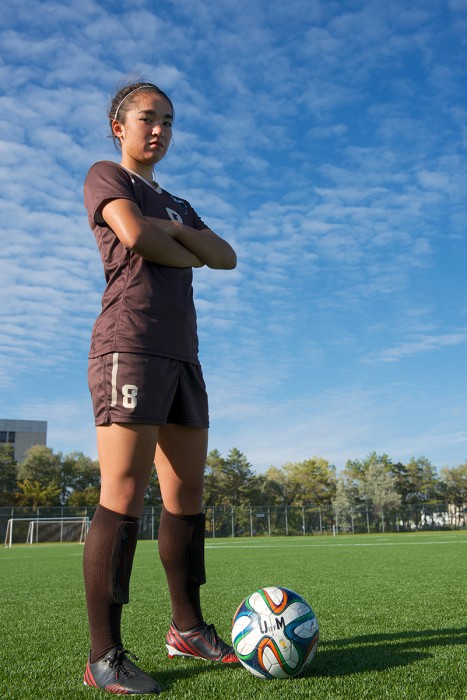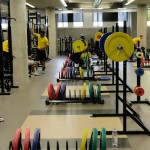
Building better Bison athletes
New High Performance Centre is perfect place to train the next generation of athletes
The training space for Bison athletes tucks neatly into a corner of the Active Living Centre. The usual suspects of pumping iron, like barbells and dumbbells, dominate its roughly 7,300 square-foot expanse. And Olympic-style lifts such as squats or clean and jerks form the bedrock of strength-building routines.
But in a room off to the side you’ll find the unusual: high-tech devices that turn all the players’ reps and regimens into meaningful data. The High Performance Centre, or HPC for short, is not your average gym.
Spindly tripods, capped by what look like tennis ball tubes filled with LED lights, lie in wait in a corner—this is the Smart Scan system. When an athlete logs in using a unique wristband, it can record their acceleration along the centre’s 30-metre track or, in the case of a soccer player, measure how quickly their head swivels from side-to-side in time with a random sequence of lights.
Vanessa Martinez Lagunas, Bison women’s soccer coach, and today’s tour guide, opens another cabinet to reveal a bank of what look like miniature winches. When attached to a barbell an athlete lifts, they record the weight and speed of the exercise, helping players and coaches track progress and make minute adjustments for optimal benefit. The goal is to build power, which translates into speed and agility—the most important components of soccer, she says.
Martinez Lagunas says the U of M is the only Canadian university with this suite of technology and equipment—adding that not many NCAA programs south of the border do either. It’s a big help for our athletes,” says Martinez Lagunas.
She’s bringing a new level of objectivity to coaching. Don’t expect her to spout some hackneyed quip like “You gotta give 110 per cent” to inspire her players. The soccer skipper—whose off-field pursuits include completing her PhD in sport science—says a good player must first be a good athlete. Creating the latter is most effective when technology merges with training.

Bison women's soccer coach Vanessa Martinez Lagunas
She says fitness tests, aided by the Smart Scan system, are her “best tools” and uses an example from her team’s recent spring ID camp for returning and prospective players—when Speedy forward Selina Speranza broke the team record for the 30-metre dash—to illustrate the point.
“That makes a difference,” says Martinez Lagunas, who arrived at the U of M in 2013. “Those milliseconds of difference, breaking a personal best, a team record—that really motivates players.”
Years of playing university, national and professional-level soccer in her native Mexico and in Europe, along with coaching professional men’s squads in Germany, exposed Martinez Lagunas to the cutting-edge union of sport and technology. She wants to bring all that “know” from the pros to her developing Bison players—one gizmo and gadget at a time.
Sets of pocket-sized devices cover the desk space of her compact Frank Kennedy office. One, about the size of a pager, slots into the back of a vest that players wear and tracks their acceleration and distance travelled using GPS. Another, strapped around their ribcage, monitors their heart rate. They too provide data to help coaches and training staff tailor each player’s training regimen.
Their efficiency and precision are a boon to athletes, whose long-term training goals might be measured in tenths of a second or centimetres.
Complementing all this tech at the HPC is a dedicated strength and conditioning team led by alumnus—and Martinez Lagunas’s fellow technophile—Matt Barr [BESS/06]. He and his colleagues Shawn Preston and Cole Scheller work primarily with Bison men’s football and women’s soccer to help them with everything from strength and fitness to the nuances of proper footwork and coordination. Barr, who says the new Active Living Centre is “unquestionably the best facility in the country”, is also helping the teams incorporate injury prevention measures into their training.

Strength and conditioning coach Matt Barr in the High Performance Centre
Tears of the ACL are common in women’s soccer—the Bison squad had three last season—so players like second-year midfielder Amanda Wong say they are eager to work with Barr to protect their bodies from such traumas. She’s also seeing how training in the HPC is adding to her game-day toolkit.
“Building strength [in my lower body] means I’m able to push someone off the ball or jump higher,” says Wong, who’s been in the strength and conditioning program for about a year.
Barr’s own path into this field was partly in response to the absence of such resources when he played rugby for team Canada. An injury ultimately led to his retirement from the sport but at the same time stoked his interest in helping better prepare future generations of athletes. The window of their success can be fleeting, so he wants to see them make the most of it.
“[An athlete’s career] is a very short time of their lives,” says Barr. “It’s also quite often the best time of their lives.”
Starting with his arrival in 2012 at the U of M, Barr focused on football—a sport where strength is necessity. His first job, he says, was changing the team culture to one that saw training sessions as mandatory. Players who missed sessions met with the scorn of teammates and repeat offenders got cut.
“[Strength and conditioning] has become a lot more structured and a lot more scientific,” says Barr, 34, who did his master’s at Western before completing a PhD from one of the meccas of strength and conditioning education: Australia’s Edith Cowan University. “Now, it’s at the point where it’s an essential part of the training that’s incorporated.”
It’s also becoming a useful recruitment tool.
Martinez Lagunas says the first thing she did this year with recruits in her spring camp was take them on a tour of the Active Living Centre, including the HPC, and Investors Group Field. “I cannot have better facilities than that,” she says.
On her wish list of acquisitions? A portable spirometer (essentially a backpack an athlete wears to measure their oxygen consumption while exercising). Barr says he would love to have a cloud-based data solution that each player could access before a training session to report how they are feeling, check off areas of their bodies that are sore, and basically give his team more details to help tailor a player’s workout and protect them from injury.
As Martinez Lagunas, fellow coaches and the strength and conditioning team collaborate on athlete development, she sees even greater integration of sport and science within the Faculty of Kinesiology and Recreation Management as another means to take things to another level—for players and researchers alike.
“Our students and researchers can help us make Bison athletes better,” says Martinez Lagunas. “[And in turn] they get that practical experience. When they get out [of school] they are ready to do that type of work.”










Please how do I join the Bisons? Am a U1 student at the U of M
Thank you for your inquiry. Please contact the coach directly for the sport in which you are interested. You will find contact information on our website: http://www.gobisons.ca/staff.aspx